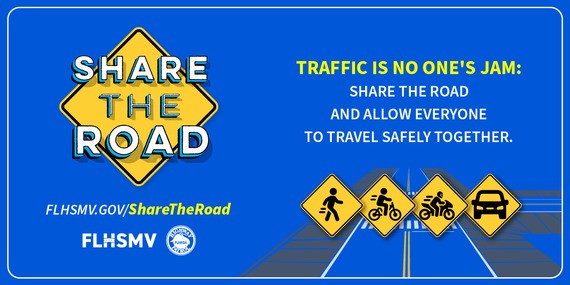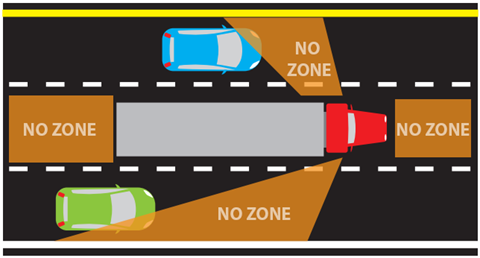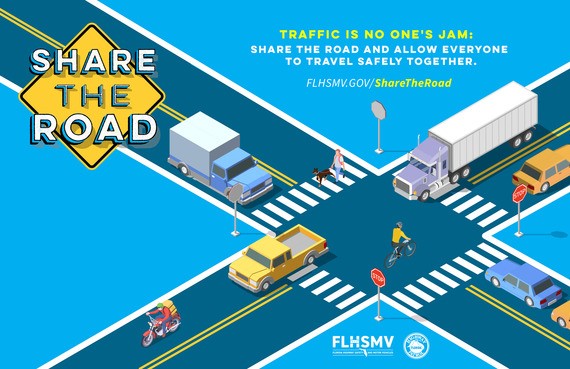Traffic is No One’s Jam: Share the Road and Allow Everyone to Travel Safely Together

~FLHSMV’ S May Public Safety Campaign Focuses on the Importance of Sharing the Road for Safe Travel in Florida~
TALLAHASSEE, Fla. – May is Share the Road Month. The Florida Department of Highway Safety and Motor Vehicles (FLHSMV), along with our partners at the Florida Department of Transportation (FDOT), Florida Sheriff’s Association (FSA), Florida Police Chief’s Association (FPCA), the Florida Trucking Association (FTA), and AAA-The Auto Club Group, want to increase awareness among Florida road users that sharing the road is not only a shared responsibility it is essential for ensuring safe travel for everyone.
Florida has a vast network of roads comprising more than 123,816 centerline miles, used by millions of residents and visitors daily. Given the diverse modes of transportation, it is critical to know how to navigate the roads safely. All road users, whether motorists, bicyclists, or motorcyclists, have the right to travel safely. Drivers must exercise added caution when driving around bicyclists, motorcyclists, and commercial motor vehicles (CMV).
“Sharing the road is a shared responsibility to make sure we all arrive safely,” said Executive Director Dave Kerner. “As a motorist, it is important to educate yourself and your loved ones about the significance of following traffic laws, being courteous to others, and staying attentive to your surroundings. Exercise caution around all types of vehicles, pedestrians, bicyclists, and vulnerable road users. Safe driving is not just a goal, it is a way of life.”
“Florida drivers and other road users often enjoy the great natural beauty our state offers,” said FHP Colonel Gary Howze II. “Take personal responsibility for your driving and choose to just be nice, taking that extra moment to look out for pedestrians, bicyclists, and other motorists when driving throughout our great state.”

- Commercial vehicle drivers play a crucial role in Florida’s economy. Their large, heavy trucks need more space, time to stop, and room to turn.
- Commercial Motor Vehicles have areas of limited visibility due to their large size, which are commonly referred to as “No-Zones.” It’s important for all motorists to be aware of these areas, as driving in them can make it difficult for Commercial Vehicle Drivers to see other vehicles on the road. This can put everyone’s safety at risk, so it’s essential to exercise caution and stay out of these No-Zones whenever possible.

- Commercial Motor Vehicles (CMVs) were involved in over 47,000 crashes while traveling throughout the state, resulting in 340 deaths and almost 1,000 serious bodily injuries. Most crashes involving CMVs occur Monday through Friday between 8 a.m. and 3 p.m.
- FHP and its Commercial Vehicle Enforcement (CVE) unit are dedicated to commercial vehicle safety. They work with commercial vehicle drivers to ensure their safety while driving on Florida’s roadways.

- Motorcycle safety is a priority in Florida. Events like Daytona Bike Week and bike fests highlight the popularity of riding and enjoying the Florida weather; however, in 2023, motorcycles were involved in 9,522 crashes in Florida, with 604 deaths and 2,123 serious bodily injuries. Riders must take all necessary safety precautions to avoid such accidents and stay safe on the roads.
- May has the sixth-highest number of crashes for the year; most occur during leisure days (Friday, Saturday, and Sunday) during the late afternoon and evening hours or when there is low visibility or poor weather conditions.
- Visit our motorcycle safety page to learn more about motorcycle safety awareness, courses, or endorsements so you can ride safe and ride again.

- According to Florida Statute 316.027(1)(b), a vulnerable road user includes pedestrians working on a highway, utility facilities along a highway, or providing emergency services within the right-of-way. A person operating a bicycle, electric bicycle, motorcycle, scooter, or moped lawfully on the roadway. A person riding an animal, a skateboard, roller skates, in-line skates, or a wheelchair.
- Over the past three years (2020-2022), approximately 74% of the hit-and-run fatalities in Florida were vulnerable road users. Additionally, vulnerable road users made up 6.52% of the total hit-and-run crashes during the same period.
- To promote safety and reduce the number of hit-and-run accidents in Florida, all road users must be aware of and follow traffic laws, including giving vulnerable road users plenty of space and being extra cautious when driving near them.
- Vulnerable road users are at a higher risk of being involved in hit-and-run accidents, with 83.74% of hit-and-run fatalities in Florida over the past three years being vulnerable road users.

- FLHSMV data shows that pedestrians have the highest fatalities among groups using Florida roadways. Pedestrians use sidewalks, crosswalks, and intersections to interact with motorists, bicyclists, motorcycles, and commercial vehicles.
- In 2023, pedestrians were involved in over 10,000 crashes in Florida, with 779 deaths and 1,393 serious bodily injuries.
- Crashes involving pedestrians most commonly occur between 6 p.m. and 9 p.m. when people enjoy Florida’s outdoors. 85% of pedestrian fatalities occur during the early morning, late afternoon, and evening.
- Pedestrians must always pay attention and avoid wearing headphones or talking on a cell phone. If possible, pedestrians should walk on sidewalks. If no sidewalk is available, they should walk facing and as far away from traffic as possible.

- In Florida, a bicycle is legally defined as a vehicle. It has all the privileges, rights, and responsibilities of a motor vehicle operator on public roads (except for expressways). It must obey all traffic controls and signals.
- Bicyclists must use the bike lane if they cannot travel at the speed of other traffic. If no bike lane is available, they should stay on the right-most side of the road.
- Bicyclists were involved in 7,129 crashes in 2023, with 211 deaths and over 800 serious bodily injuries. Bicycle crashes are highest during weekdays (M-F) and peak in the late afternoon and evening hours.
“Florida is home to millions of residents and tourists year-round. As you travel on our roadways, remember to ‘Share the Road’ with motorcyclists, bicyclists, and commercial vehicles so everyone can arrive alive,” said Nassau County Sheriff Bill Leeper, President of the Florida Sheriffs Association. “The Share the Road campaign saves lives. On behalf of Florida’s Sheriffs, we ask everyone to be cautious and mindful of everyone on the road.”
FPCA President Charles “Chuck” Broadway, “For this year’s Share the Road campaign, the Florida Police Chiefs Association encourages everyone on the road to practice respect and cooperation. By being considerate and cautious, we make the roads safer for all road users. Join us in making a commitment to safety and respect on the road this May.”
“It’s vital for all people to be vigilant and learn how to Share the Road with pedestrians and all types of vehicles, said Alix Miller, President and CEO of the Florida Trucking Association. “Commercial motor vehicles and buses have specific operating limitations that everyone should be educated about to stay safe. We’re grateful for the State of Florida, who funded our Share the Road PSA series, and can be watched and shared by visiting www.floridatrucking.org/sharetheroad.”
“Pay attention and allow everyone to get to their destination safely,” said Michele Harris, Florida Public Affairs Director, AAA-The Auto Club Group. “Take the time to give all types of road users the room they need.”

- Always watch for bicycles and look carefully before entering an intersection, changing lanes, or even opening a car door.
- Never follow too closely behind a bicycle. As Florida law requires, it’s important to give bicyclists at least three feet of clearance. Use caution when driving alongside or passing them.
- Drivers should maintain a four-second buffer zone between themselves and motorcyclists and increase space when encountering bad weather and road conditions. The force of a wind gust can cause the rider to lose control.
- Motorists must never attempt to share the lane with a motorcycle. Motorcyclists are entitled to the entire lane.
- Motorists should stay out of the “No Zone.” Commercial vehicles have large blind spots in front, behind, and on both sides of the vehicle, which is known as the “No Zone.” Even though large vehicles have several rear-view mirrors, other vehicles will be hidden from view if they are within the “No Zone” or blind spot.
- Do not tailgate; you’ll be in the rear blind spot and may collide with the truck if it stops unexpectedly.
- Pass trucks on the left side for maximum visibility. Avoid cutting in too soon when passing a truck. Large vehicles cannot stop as quickly as other vehicles.
- Keep to the right side of your lane when a truck passes you. Do not speed up while the truck is passing you.
To learn more about the FLHSMV Share the Road campaign, visit our website and view the statistics on our campaign analytics dashboard. To report dangerous driving, dial *FHP (*347).

###
The Florida Department of Highway Safety and Motor Vehicles (FLHSMV) provides highway safety and security through excellence in service, education, and enforcement. Learn more on our website.
The Florida Highway Patrol strives to achieve core values of courtesy, service, and protection. It is FHP’s job to help ensure the safety and welfare of millions of Florida’s residents and visitors every day.
To learn more about FHP or how to become one of Florida’s Finest, visit BeATrooper.com.

Dave Kerner, Executive Director